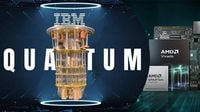On October 24, 2025, the world of advanced computing witnessed a seismic shift as IBM announced a breakthrough that could dramatically accelerate the journey toward practical quantum computers. In a move that sent shockwaves through both the technology and financial sectors, IBM revealed it had successfully run a crucial quantum error-correction algorithm in real time on a standard, commercially available AMD field-programmable gate array (FPGA) chip. This development, completed a year ahead of schedule for IBM’s ambitious Starling quantum computer project, marks a pivotal moment in the race to make quantum computing both reliable and accessible.
Quantum computers, for all their promise, have long been hampered by the fragility of their fundamental building blocks: qubits. These quantum bits are notoriously susceptible to environmental “noise,” which can quickly corrupt their state and lead to calculation errors. Real-time error correction isn’t just a nice-to-have—it’s an absolute necessity if quantum machines are ever to tackle complex, real-world problems. Until now, running these demanding correction algorithms required bespoke, expensive hardware, further complicating the already daunting task of building scalable quantum systems.
IBM’s latest achievement, however, turns that paradigm on its head. By demonstrating that their error-correction algorithm can run ten times faster than required on off-the-shelf AMD hardware, the company has shown that the future of quantum computing may not depend on exotic, custom-built components after all. As Jay Gambetta, IBM’s Vice President of Quantum, put it to Reuters, “Implementing it, and showing that the implementation is actually 10 times faster than what is needed, is a big deal.” The use of affordable, flexible AMD chips makes real-time error correction not only feasible but practical, opening the door to wider adoption and faster innovation.
This leap forward is no isolated event. It’s the first major fruit of a strategic alliance between IBM and AMD, formalized in August 2025, aimed at developing next-generation, quantum-centric supercomputing architectures. The partnership brings together IBM’s expertise in quantum chips and AMD’s prowess in CPUs, GPUs, and FPGAs. Both companies’ leaders have been vocal about the transformative potential of this hybrid approach. IBM CEO Arvind Krishna declared, “Quantum computing will simulate the natural world and represent information in an entirely new way… [working] together… we will build a powerful hybrid model that pushes past the limits of traditional computing.” AMD’s CEO Lisa Su echoed this vision, stating, “By converging high-performance and quantum computing, we see tremendous opportunities to accelerate discovery and innovation.”
The technical details behind the announcement are as significant as the headlines. IBM’s error-correction algorithm, first introduced in June, was designed to detect and fix errors in qubits on the fly—an essential step toward building fault-tolerant quantum machines. According to IBM, the implementation on AMD’s FPGA was completed a full year ahead of schedule for the company’s Starling quantum computer, which is targeted for launch by 2029. This rapid progress underscores IBM’s accelerating roadmap and its determination to stay ahead in an increasingly crowded field.
The competitive landscape has never been more intense. Just days before IBM’s announcement, Google revealed its own quantum algorithm breakthrough, claiming “verifiable quantum advantage” with its new “Quantum Echoes” algorithm. Microsoft, meanwhile, is pursuing a dual strategy: backing a major neutral-atom quantum computer while also developing experimental “topological qubits” that could, in theory, eliminate the need for complex error correction altogether. Amazon’s AWS is charting its own course with the Ocelot chip, engineering “bosonic qubits” designed to suppress errors at the hardware level from the outset. Each of these approaches comes with monumental engineering challenges, and it remains to be seen which will ultimately prove most scalable or commercially viable.
Yet, as Winfried Hensinger, a professor at the University of Sussex, observed following Google’s news, these rapid-fire advancements are “yet another convincing proof that quantum computers are gradually becoming more and more powerful.” The focus in the quantum race is shifting away from raw qubit counts and theoretical performance toward the engineering of verifiable, repeatable, and practical systems—systems that can operate using today’s hardware, not tomorrow’s wish list.
The market’s reaction to IBM and AMD’s news was immediate and emphatic. On October 24, IBM’s stock soared 8.2% to $308.32, its highest close since 2022, while AMD’s shares hit a record intraday peak near $253, up approximately 8%. Both companies closed at all-time highs, reflecting investor enthusiasm for their quantum and AI strategies. AMD, already a dominant force in AI and data center hardware, has seen its shares more than double year-to-date in 2025. IBM, for its part, is up roughly 40% this year, making it one of the Dow’s top performers. As Investopedia aptly put it, the event “took a quantum leap” in both companies’ prospects.
AMD’s influence extends beyond quantum. Its new EPYC 4005 series processors are powering Super Micro Computer, Inc’s latest AI servers, supporting efficient data center solutions for cloud providers and businesses focused on AI inference and online gaming. The company’s chips are at the heart of Supermicro’s MicroBlade multi-node solution, providing powerful, affordable systems that modernize data centers. AMD’s recent collaborations—including a landmark deal with OpenAI to supply up to six gigawatts of computing capacity using next-generation Instinct MI450X GPUs—underscore its expanding role across next-generation technologies.
For IBM, the successful demonstration of error correction on AMD hardware validates its hybrid quantum-classical computing vision. The company’s partners, including Japan’s RIKEN institute, are already linking IBM quantum modules to classical supercomputers such as Fugaku, further advancing the integration of quantum and classical resources. These developments suggest that the age of hybrid, practical quantum computing is not just a distant dream but an approaching reality.
Industry analysts are cautiously upbeat about what lies ahead. Investors will be watching closely as both companies prepare for upcoming earnings reports and provide guidance on how these technological advances will translate into commercial gains. For now, one thing is clear: the quantum race is heating up, and the winners may be those who can bridge the gap between cutting-edge theory and practical, scalable solutions using today’s hardware. With IBM and AMD’s partnership, that future seems closer than ever.
As the dust settles on this week’s announcements, the message is unmistakable: quantum computing is no longer confined to the laboratory. With practical error correction running on affordable, widely available chips, the next era of computing may be just around the corner.





